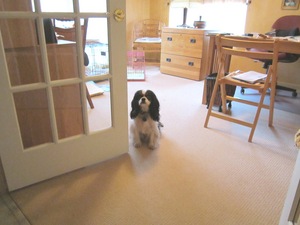Bringing a new pet into your home as a holiday gift can be a recipe for separation anxiety

Julia Levitt | Contributor
Don’t laugh too hard when I say with a completely straight face that this is a stressful time of year for humans. To add to the mix of stress, can you imagine some people want to have a Christmas puppy?
It is not as though you can call up L.L. Bean and order a puppy in the size and color you want. Then what happens? You bring home an 8-week-old puppy when chaos reigns supreme — from now until the first of the year.
When I listen to my friends talk about holidays, they are anything but happy — stressed but not happy. So when you get a dog at this time of year, you bring home a new puppy to complete chaos.
Let’s begin with the Christmas tree. Did you know tinsel is toxic? Wrapping paper hides hard plastic wrappers. There are lots of relatives, not to mention those yummy food smells, and hopefully tastes from scraps that unsuspecting kids drop on the floor.
A new puppy needs calm and quiet. A new puppy requires loads of attention. A new puppy needs structure… a new puppy needs a routine… should I go on?
Then as quickly as the new member is brought in to his/her new environment, he or she is left for hours at a time as we go back to work. Has anyone thought to prepare the new puppy ? All of the above situations — the unstructured environment in an atypical home environment for a new puppy — set the stage for separation anxiety.
Here’s what canine expert Martin Deeley has to say on the subject…
Martin Deeley knows dogs — he has been training dogs for more than 30 years. Deeley has devised created and produced 13 training videos on dog training . He is considered "a trainer of trainers." Deeley also holds workshops on dog training in the U.S and Europe.
Deeley points out the following:
"However separation anxiety manifests itself, there is no doubt that it is often unknowingly encouraged by owners. We make a big fuss when we leave or come home and, in doing so, we reward the concern and the stress increases at the time of leaving….With some dogs, a change in their routines can create the symptoms of separation anxiety. After being spayed or neutered, we spoil them because they have been to the vet and had an operation. We feel sorry for them and reinforce their 'neediness.'"
Some destruction and stress can be created by boredom and lack of exercise or even by the characteristics of the breed. Terriers are born to dig , retrievers to carry and protection breeds to protect.
Whatever breed we choose, it is important from the start of our new relationship with the puppy that certain behaviors become routine. Here are a few of Deeley’s suggestions:
"Even when you are at home, have your dog familiar with and accepting of being in the crate. Star with short periods of time and then increase it. Feed him in the crate, let him have his favorite stress reliever in there to gnaw on —a Kong type toy, a sterile bone or a nylon hard bone.
When you leave him, do so quietly and don’t provide cues. Cues are: go through your leaving routine quietly, pick up your car keys, open the garage doors and then start the car. Some times, Deeley continues, your dog will recognize a series of actions. You have to be clever. Changing your dog's habits often means changing your own, and that can be difficult — we are creatures of habit. Change your routines: use a different door, put your coat on in different place.
Separation anxiety can be overcome, Deeley continues. With some dogs you can turn them around fairly quickly. With others it takes time and patience. Exercise, obedience, leadership, limits and boundaries give dogs confidence in you and confidence in themselves. Security with their environment and consistency within the whole family pack will have you moving forward towards a balanced, stress-free dog and, of course, a stress-free you.
In my next post, I will discuss separation anxiety from dog trainer Cheri Lucas's point of view.
Julia Levitt is the founder of In Harmony Dog Training (www.inharmonydogtraining.com) in Ann Arbor. She can be reached at julia@inharmonydogtraining.com or at 734-645-4707. Julia provides individual training for dogs and their owners, and also conducts dog training classes at Ann Arbor Animal Hospital.

